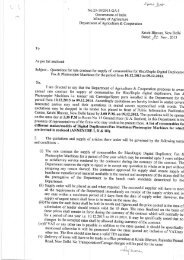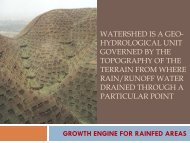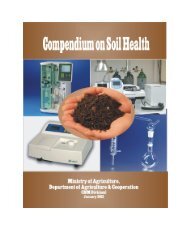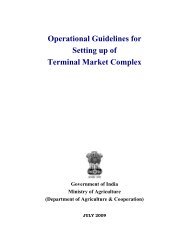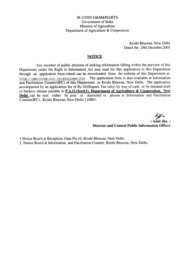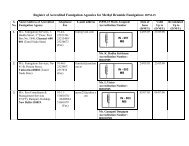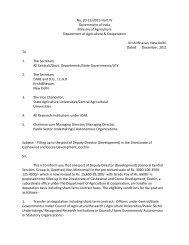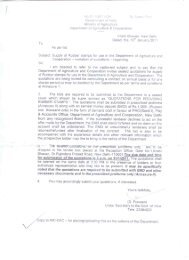Future Requirements of Agricultural Machines for Mechanizing ...
Future Requirements of Agricultural Machines for Mechanizing ...
Future Requirements of Agricultural Machines for Mechanizing ...
Create successful ePaper yourself
Turn your PDF publications into a flip-book with our unique Google optimized e-Paper software.
Table 1. Population Growth Trends in Mechanical Farm Power Sources in India<br />
additional functions with the help <strong>of</strong> proper attachments.<br />
Large farm machines are <strong>of</strong>ten self propelled with built<br />
in power source. These farm power sources are<br />
commercially available but their distribution and<br />
availability and use in certain regions like E and NE<br />
and hilly areas can not be considered satisfactory<br />
(Table 3). There is close nexus between farm power<br />
availability and agric productivity (Fig. 1). The level <strong>of</strong><br />
farm power availability during 2001 was about 1.35 kW/<br />
ha (Table 2). At the present level <strong>of</strong> sophistication in<br />
◆ 178 ◆<br />
STATUS OF FARM MECHANIZATION IN INDIA<br />
(number in million)<br />
1950 1960 1970 1980 1990 1997 2000* Growth rate<br />
(%) Base<br />
year 1970<br />
Tractive power<br />
Tractor 0.008 0.031 0.148 0.518 1.222 2.037 2.471 9.84<br />
Power Tiller - - 0.003 0.021 0.040 0.085 0.110 12.7<br />
Stationary power<br />
Electric pump 0.020 0.100 1.629 4.330 6.019 8.254 9.525 6.06<br />
Diesel pump 0.083 0.230 1.546 3.101 4.659 5.899 6.465 4.88<br />
Others<br />
Power sprayer/duster - - 0.045 0.124 0.200 0.245 0.311 6.66<br />
Note: *Estimated<br />
Source: Singh, et al., 1999<br />
Table 2. Availability <strong>of</strong> Farm Power in India<br />
Year Total Power, Source-wise%<br />
KW/ha<br />
Animal Mechanical Electrical<br />
1951 0.25 97.4 2.1 0.5<br />
1961 0.31 94.9 3.7 1.4<br />
1971 0.36 79.2 16.3 4.5<br />
1981 0.63 48.2 32.3 19.5<br />
1991 0.92 34.5 34.7 30.8<br />
2001 1.35 18.0 55.0 27.0<br />
(36.68)<br />
Note: *Figure in parenthesis is mobile farm power<br />
Power, kW/ha<br />
1<br />
0.9<br />
0.8<br />
0.7<br />
0.6<br />
0.5<br />
0.4<br />
0.3<br />
0.2<br />
0.1<br />
0<br />
1950 1954 1958 1962 1966 1970 1974 1978 1982 1986 1990 1994 1998<br />
Animate power, kW/ha Mechanical power, kW/ha<br />
Total power,kW/ha Productivity, kg/ha<br />
Fig. 1. Trend <strong>of</strong> farmpower availability and land productivity in India<br />
1.8<br />
1.6<br />
1.4<br />
1.2<br />
1<br />
0.8<br />
0.6<br />
0.4<br />
0.2<br />
0<br />
Land productivity, kg/ha<br />
Table 3. Farm Power availability in NEH Region<br />
State Availability farm power,<br />
hp/ha <strong>of</strong> cropped area<br />
Arunachal Pradesh 0.23<br />
Manipur 1.40<br />
Meghalaya 1.44<br />
Mizoram 0.77<br />
Nagaland 0.45<br />
Tripura 0.99<br />
agriculture <strong>for</strong> taking two crops per year an average farm<br />
power available <strong>of</strong> 2.0 KW/ha is considered essential.<br />
<strong>Agricultural</strong>ly advanced states and regions in the country<br />
have farm power availability <strong>of</strong> 2-4 kW/ha. Law <strong>of</strong><br />
diminishing return is also applicable in farm power<br />
availability and mechanization. Excessive<br />
mechanization does not bring rewards instead block the<br />
capital, add to overhead costs and at times cause<br />
indebtness and its negative impacts.<br />
2.1 Status <strong>of</strong> Farm Implements and <strong>Machines</strong><br />
2.1.1 Land and Water Resource Development<br />
Equipment: It involves clearing <strong>of</strong> land <strong>of</strong> the unwanted<br />
vegetation, levelling and grading so as to per<strong>for</strong>m field<br />
operations properly and apply seed, fertilizer/manure,<br />
and irrigation water uni<strong>for</strong>mly. It also involves creating<br />
access to field and mobility <strong>of</strong> machines through farm<br />
roads with irrigation and drainage ditches, creating<br />
irrigation water resources both surface and ground water.<br />
Most ancient practice <strong>of</strong> land development was use <strong>of</strong><br />
fire and later on slash and burn a practice still vogue in<br />
a few remote areas. However, axe, hoe, pickaxe, spade,<br />
crowbar, and heavy duty ploughs have come in use and<br />
still in vogue where mechanization has not advanced.<br />
Subsequently not long ago animal drawn buck scraper,<br />
floats, V-ditchers, bund <strong>for</strong>mers were developed and<br />
got in use <strong>for</strong> levelling, smoothing, land shaping. With<br />
industrial revolution and development <strong>of</strong> IC-engines and



